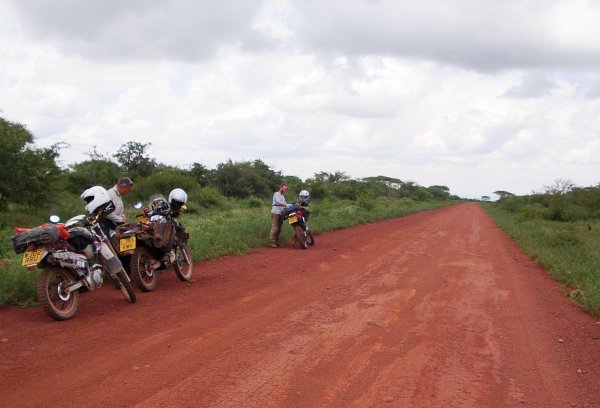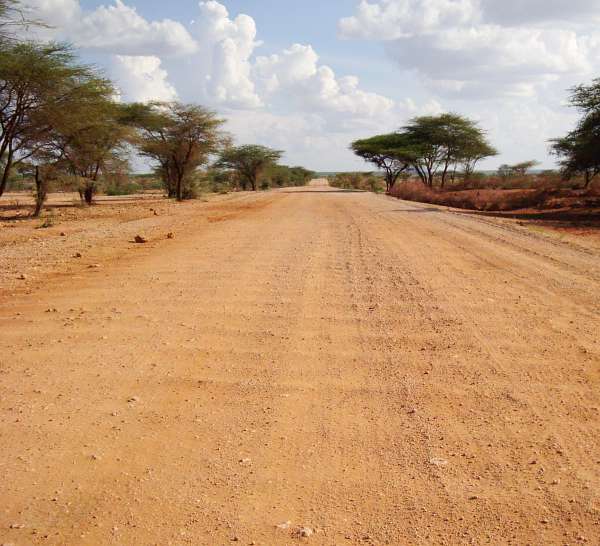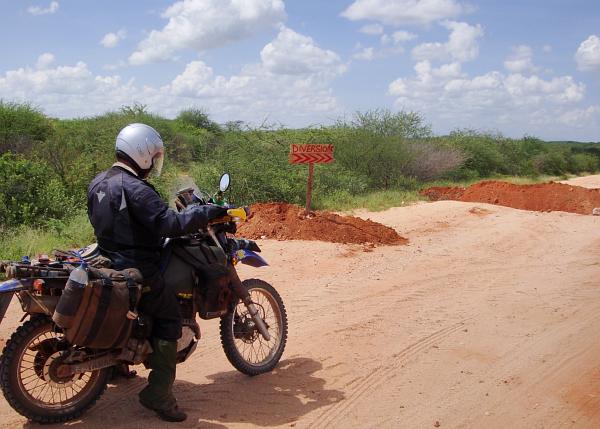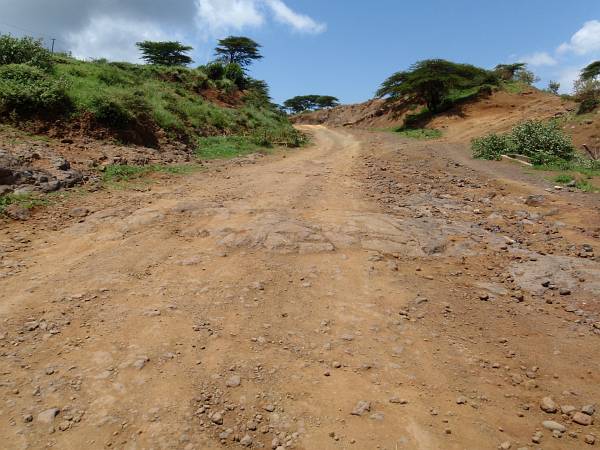Isiolo - Part 2
Marsabit to Isiolo.
Travellers say this section is even worse than the previous, Moyale to Marsabit. We were keen to find out. Well, we had no choice really.
It started off OK, as it did when leaving Moyale.

Reasonably comfortable.

With little villages and tea houses again.

But getting hotter as we enter the Kaisut Desert. A lot hotter than in the Dida Galgalu Desert between Moyale and Marsabit.

And things get worse hereon......

The railway chippings were less deep than on the previous days, taking less control of the front wheel and its direction of travel. It was this 'riding on marbles' experience that persuaded Caroline to take a seat in Bodo's truck a couple of times before Marsabit, but she rode the whole two days to Isiolo with no more get-offs.


But the corrugations return.

They're at their worst when the rear wheel fits precisely in one corrugation and the front precisely in the next - for hundreds of yards at a time.
There's a big debate about what speed to ride at over these deep ripples. Some say fast, so the suspension smooths them out, others say that will shake a loaded bike to pieces, best to go slowly when there's a couple of hundred miles of them.
What happens in fact is that the depth of the corrugations seems to have little effect, and you find yourself accelerating up to a resectable speed over quite deep ones with little shaking or bouncing from the bike. This unfortunately removes the motivation to look around the road to find a track that is flat, if there is one.
Then suddenly, in an instant, the bike feels as though both brakes have been applied very hard, you're thrown way forward towards the handlebars, the bike shakes and vibrates viciously and your eyes wobble so much you can't see the road's surface anymore. What's happened is that the spacing of the corrugations has changed so that both wheels fit precisely in the dips at precisely the same time. And if they are at an angle to your direction of travel, they take control of the steering as well and send you in their direction, not yours.
The important thing to do here, as with any sudden and difficult change of road surface, is not to grip the handlebars or controls in a sudden panic, or brake, or anything, except relax the grip for an instant before doing anything else. Luckily, the sudden and violent shaking of the bike and its handlebars, and the accompanying deafening noise, bring on a moment of deep paralysis and you can't do anything anyway.
The braking effect is quite fierce so that takes care of slowing down a bit, and when your brain has stopped banging about in your head you realise a lower gear is needed, but more importantly the urge to search out a smoother path suddenly returns. So a pretty quick gearchange, and rapidly taking control of the steering again, usually brings back a little peace and serenity and allows breathing to continue once again.
And don't forget to be on the constant lookout for a smoother track, maintaining the speed necessary to steer across the ridges to reach it.

More little villages. Bodo's truck competing for attention.

And more tribal costumes. Quite common, and very elaborate and colourful in this part of northern Kenya.

The corrugations over these two days were certainly more severe, relentless and difficult to avoid (if at all) than on the previous days.



To keep it interesting over these distances, occasional networks of deep random drainage ditches cut by recent rains appeared in our path.
Boring it ain't.

With occasional groups of baboons along the way.

A stop for a breather. And then........

A diversion, of all things!

WHERE does this lead to??

Well, it just led to more bumpy dirt, stoney ridges, muddy drainage ditches, dried-up riverbeds, corrugated ruts, rocks and boulders of all shapes and sizes, running in the same direction not far from the existing road.
Over there we could see the occasional worker and mechanical contraption engaged in some mysterious ritual, continuing on for about the next twenty miles.
And closer to Isiolo, another diversion sign, which led us on to THIS:

Don't know what they're cheering for - all the fun has come to a screeching halt!
Tarmac all the way to Cape Town now.
(Unless you take the occasional side road, which we have).
This was a little way before Archer's Post.
Next were the crossroads outside Isiolo, and the sign for Garba Tula Road and our campsite.

Which tells its own story.
So, a little review of this most notorious of East African 'green lanes'.
If you took the most difficult stretches of this road, cut them up into four or five three-mile lengths, planted them in the Surrey Hills or Brecon Beacons and rode them one Sunday morning for a day of green-laning, by the time you reached the lunchtime pub you'd be disappointed, and searching desperately for something far more challenging for the afternoon.
The challenging and daunting thing about this road is its sheer length.
Roughly, riding your bike from Whyteleafe to Newcastle, all on dirt, through two deserts.
But that's growing shorter every day with the advance of the tarmac. So we wonder what will happen to the little villages along the way.
We took five days to cover it, keeping together as a group of five vehicles and seven travellers. Some have covered it in one. Two days is not unusual, three being more the average. Usually by people on their own or just a team of two. Probably we could have covered it more quickly in groups of ones or twos, but would then almost certainly have joined that large band of travellers needing frames, chassis and suspension welding up in Isiolo.

Street scenes in Isiolo.

And yes, in town, the tarmac is replaced with - mud, boulders, stones and massive drainage ditches. So the fun hasn't entirely gone!

Isiolo is on the northern foothills of Mt Kenya, second highest in Africa. Snow-covered at this time of year, just visible in the distance.
